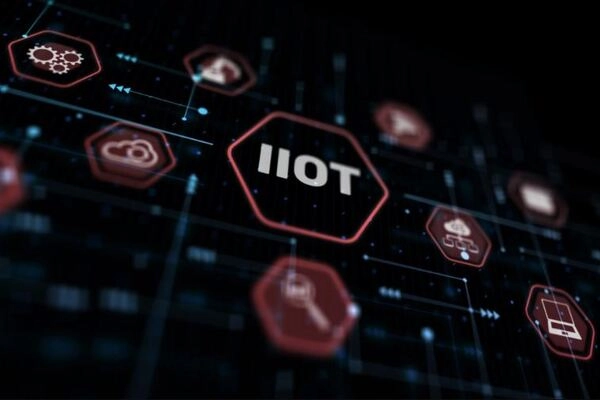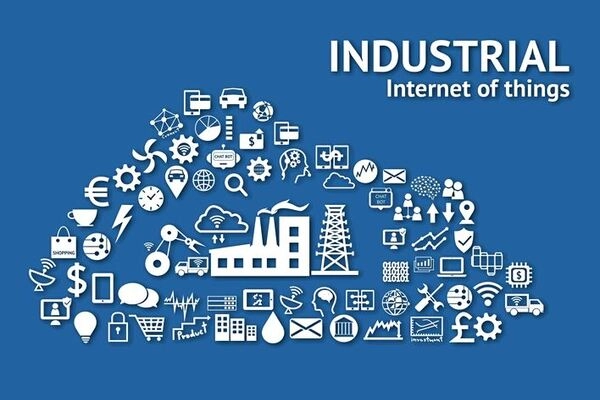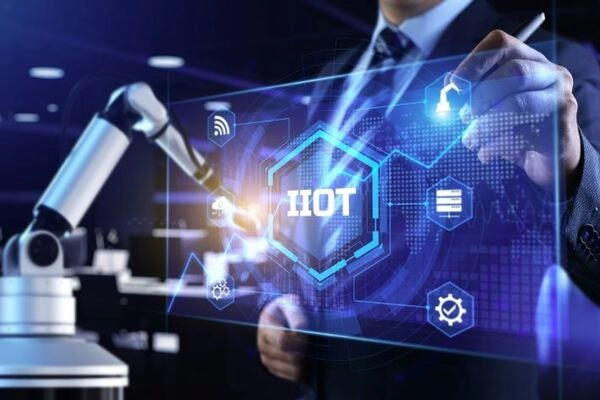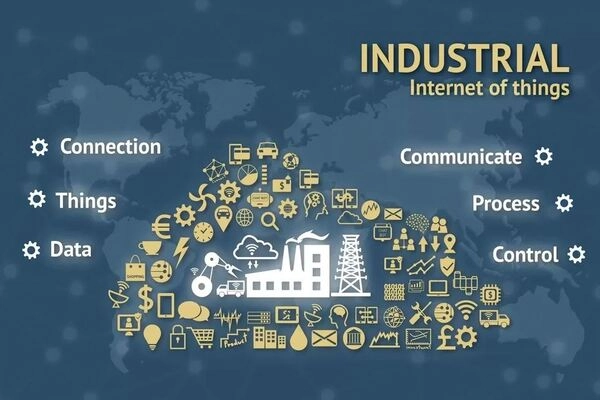In the era of Industry 4.0, the question “What is Industrial IoT?” has become crucial for businesses aiming to digitalize their production processes. IIoT (Industrial Internet of Things) is a technology that connects devices, sensors, and machinery within industrial environments, enabling data collection, analysis, and operational optimization. Understanding what IIoT is helps enterprises enhance efficiency, reduce costs, and improve product quality in a smarter and more effective way.
What is Industrial IoT?
In the age of digital transformation and Industry 4.0, the concept of IIoT has become a key topic of interest for companies in manufacturing, logistics, energy, and automation. IIoT (Industrial Internet of Things) is an advanced extension of IoT (Internet of Things), but with a specific focus on industrial applications.

While IoT focuses on connecting consumer devices such as smartphones, TVs, and smartwatches to serve everyday needs, IIoT (Industrial Internet of Things) is designed to connect machinery, sensors, control systems, and management software within industrial environments. Its main goal is to help businesses monitor, analyze, and optimize their entire operations in real time.
For example, a manufacturing plant can use IIoT to track machine conditions, detect technical issues early, automatically adjust production lines in case of malfunctions, or predict maintenance schedules. All of this is achieved through a network of smart, connected devices powered by data processing and artificial intelligence (AI).
Key Advantages of the Industrial Internet of Things (IIoT)
The rapid development of industrial IoT is not just a passing trend but a true revolution in how businesses operate. IIoT offers outstanding benefits—helping organizations reduce costs, boost productivity, and ensure safety throughout the manufacturing process.

Below are the key advantages of IIoT in modern industrial sectors:
1. Real-time monitoring and improved production efficiency
IIoT sensors and devices enable businesses to monitor production lines 24/7. Continuous data updates allow engineers to track machine performance, detect issues early, and minimize downtime, resulting in smoother and more efficient operations.
2. Cost and resource optimization
With powerful data collection and analysis capabilities, IIoT systems help organizations identify areas with high energy consumption, optimize workflows, and reduce waste. This leads to significantly lower operational costs while continuously improving productivity.
3. Predictive maintenance
Instead of performing costly scheduled maintenance, IIoT enables accurate predictions of when equipment actually needs servicing, based on real-time performance data. This approach reduces repair expenses, minimizes unexpected breakdowns, and extends the lifespan of machinery.
4. Enhanced workplace safety
Industrial IoT systems can monitor environmental conditions such as temperature, humidity, toxic gases, and vibration levels to provide early warnings of potential hazards. As a result, workers are better protected, and production processes remain safer and more stable.
Key Components of an IIoT System
To gain a deeper understanding of what IIoT is, it is important to examine the components that make up a complete Industrial IoT system. IIoT is a complex technological ecosystem where multiple elements work together to ensure smooth operation.
1. Sensors and Edge Devices
These are the “frontline” components of an IIoT system, responsible for collecting data from machinery and the environment. Examples include sensors measuring temperature, pressure, humidity, rotational speed, energy consumption, or the operational status of motors.
Edge devices often have the capability to perform preliminary data processing on-site (edge computing), reducing the load on central servers and speeding up response times.
2. Network Infrastructure
Once data is collected, it needs to be transmitted to the processing center. IIoT communication networks can use industrial Ethernet, Wi-Fi, 5G, LPWAN, or specialized protocols such as MQTT and OPC UA.
Network speed, reliability, and security are critical, as IIoT systems require continuous operation and real-time data updates.
3. Data Storage and Analytics Platforms
At this stage, data is stored, aggregated, and analyzed through cloud computing or edge analytics. These systems leverage AI, machine learning, and big data to identify trends, predict equipment failures, and optimize production performance.
4. Applications and User Interfaces
Finally, analysis results are presented via intuitive dashboards, allowing operators to monitor, control, and make informed decisions. IIoT dashboards can display real-time data, productivity charts, risk alerts, or automated process adjustment recommendations.
How Industrial IoT Works
To fully understand IIoT, it is essential to know how the system operates. Industrial IoT functions by connecting devices, machinery, sensors, and control systems through the Internet. Data is continuously collected, transmitted, processed, and analyzed to support real-time decision-making.

How IIoT Works: Three Main Stages
1. Data Collection from Sensors and Devices
Sensors, actuators, and industrial machinery are installed throughout the production system to collect data such as temperature, pressure, vibration, rotational speed, and energy consumption.
This information is then transmitted to a central processor (gateway) or cloud platform for storage and further processing.
2. Data Transmission and Processing
Sensor data is transmitted over industrial networks, which may include industrial Ethernet, Wi-Fi, 5G, or LPWAN, depending on system requirements.
At the processing center, the data is analyzed using AI, machine learning, or statistical algorithms to detect anomalies, predict failures, or optimize production processes.
3. Feedback and Automation
After analysis, the IIoT system can automatically send control commands to machinery or provide actionable recommendations to operators.
For example, if an engine shows signs of overheating, the system can automatically adjust its rotational speed or alert maintenance engineers.
This enables businesses to minimize breakdowns, reduce operational costs, and improve overall efficiency.
Factors Driving the Growth of IIoT
The rapid development of Industrial IoT (IIoT) is not accidental. It is driven by a combination of technological and economic factors, especially in the era of digital transformation.
- Advances in Sensors and Smart Devices: Today’s sensors are compact, cost-effective, and highly connected. This allows sensors to be installed on almost any equipment in a factory, from production lines to energy systems.
- 5G Networks and High-Speed Connectivity: 5G technology offers ultra-low latency, high data transfer speeds, and the ability to connect millions of devices simultaneously. This provides a crucial foundation for smart factories to operate in real time.
- Cloud Computing and Edge Computing: Cloud computing enables large-scale data storage, processing, and analysis, while edge computing processes data at the source—reducing network load and improving response times. The combination of both ensures IIoT systems are powerful and flexible.
- Artificial Intelligence (AI) and Machine Learning: AI analyzes IIoT data to predict equipment failures, optimize supply chains, and automate operations. This makes IIoT truly “intelligent,” rather than just a network of connected devices.
- Demand for Production Optimization and Energy Efficiency: Competitive pressure forces businesses to improve efficiency, cut costs, and enhance quality. IIoT achieves this through automation and real-time data insights.
Comparing IIoT and IoT – Key Differences
Although both IIoT and IoT are based on the concept of connecting devices, they differ significantly in purpose, complexity, and impact:
| Criteria | IoT (Internet of Things) | IIoT (Industrial IoT) |
| Main Objective | Enhance personal convenience and automation in daily life (smart homes, smart cars) | Optimize industrial processes, operations, and management |
| Reliability & Security | Moderate requirements | Extremely high, directly affecting factory operations |
| Complexity | Low to medium | Low to medium
High, integrating multiple systems and industrial communication standards |
| Impact of System Failure | Minor | Can cause significant financial losses and safety risks |
| Data & Processing Speed | Small-scale data, simple processing | Large-scale data, real-time processing |
Practical Applications of Industrial IoT in Manufacturing and Business
Industrial IoT is not just a theoretical concept—it has been widely implemented across various industries. The following sectors highlight the real-world power and benefits of IIoT.

1. Predictive Maintenance
Traditionally, machinery was maintained on a fixed schedule or only after a failure occurred. With IIoT, sensor data is continuously analyzed to detect early signs of malfunction. This allows businesses to perform maintenance at the right time, reducing downtime and extending equipment lifespan.
Example: In an automotive manufacturing plant, sensors monitoring engine vibration and temperature can predict when bearings need replacement before a breakdown occurs.
2. Smart Supply Chain Management
Industrial IoT enables tracking of goods, materials, and transportation vehicles throughout the entire supply chain. From factory to warehouse, and from warehouse to customer, every stage is monitored automatically. This reduces errors, speeds up delivery, and ensures product quality.
3. Production Process Optimization
Real-time data from IIoT allows manufacturers to optimize production line efficiency, reduce energy waste, and improve quality control.
Example: An electronics factory can adjust the speed of welding robots based on precision measurements captured by optical sensors.
4. Energy and Resource Management
IIoT helps monitor electricity, water, and compressed air consumption, identifying areas of waste and suggesting efficiency improvements. This is a key factor for smart factories aiming for sustainable operations.
5. Applications in Logistics and Transportation
Sensors installed on trucks, containers, or warehouses monitor location, temperature, humidity, and cargo condition. This enables logistics companies to optimize routes, reduce fuel costs, and ensure the safe delivery of goods throughout the supply chain.
Challenges in Implementing Industrial IoT
Although Industrial IoT offers significant benefits, its implementation comes with several challenges, arising not only from technology but also from human factors and organizational infrastructure.
- Data Security and Safety: IIoT connects thousands of devices within a single network. Without proper security measures, the system can become a target for cyberattacks. Businesses need to implement data encryption, multi-factor authentication, and continuous security monitoring to minimize risks.
- Integration with Legacy Systems: Many factories still use older equipment and software that do not support IoT connectivity. Integrating these legacy systems with new IIoT solutions requires substantial investment and careful transition planning.
- High Initial Investment: Deploying IIoT demands investment in sensors, data platforms, cloud computing, and skilled personnel. Companies must clearly define ROI goals to avoid wasting resources.
- Lack of Skilled Workforce: IIoT technology requires engineers with expertise in automation, programming, data analysis, and cybersecurity. Currently, this specialized workforce is limited, especially in developing countries.
- Standardization and Compatibility: IIoT platforms from different vendors are often not fully compatible. Standardizing communication protocols, data formats, and APIs is essential for scalable and effective IIoT deployment.
The Future of IIoT in the Era of Industry 4.0
The future of Industrial IoT is considered one of the core pillars of Industry 4.0, driving smarter, more connected, and highly efficient industrial operations.

In the next 5–10 years, IIoT will go beyond simply connecting devices, moving toward full automation, intelligent data analytics, and AI-driven decision-making. Smart factories will become the new standard in manufacturing.
Technologies such as 5G, edge computing, digital twins, and blockchain will make IIoT more powerful, ensuring fast, accurate, and secure data processing. At the same time, IIoT will support green manufacturing, energy efficiency, and emission reduction, aligning with global sustainability trends.
With the current pace of digitalization, Industrial IoT is not just a technology of the future – it is a core driver enabling manufacturers to modernize operations, enhance competitiveness, and integrate deeply into the global value chain.
This article has provided a clear understanding of what IIoT is, the role of Industrial IoT, and its impact on reshaping modern manufacturing. IIoT is not only a technological trend but also a strategic foundation that helps businesses optimize processes, reduce costs, and increase productivity. Through real-time data analytics, predictive maintenance, and intelligent automation, IIoT is transforming traditional factories into smart factories, paving the way for the era of Industry 4.0.
